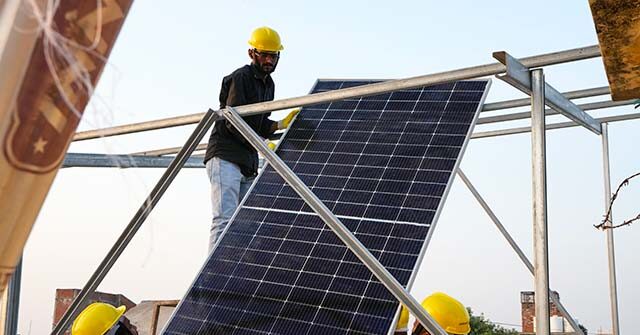In a recent report by Standard & Poor’s CRISIL analytics firm, it was predicted that India is set to emerge as a significant exporter of solar energy equipment by 2029. The analysis highlights that India has positioned itself favorably for the solar sector through a range of supportive policies, an abundant skilled labor force, and the ability to procure the necessary raw materials for solar manufacturing. The Indian government, notably through its Ministry of New and Renewable Energy, has enacted measures aimed at fostering a conducive environment for solar energy development. These include enabling foreign direct investment, offering specialized financing for solar initiatives, backing solar energy research, and providing state-level subsidies intended to boost domestic solar production.
The Indian government has also imposed considerable tariffs on imported solar cells to bolster local manufacturers. While these tariffs have been strategically designed to protect and enhance the domestic solar industry, some businesses argue that they are excessively high. This situation creates challenges for those companies that rely on imported components, as the increased import costs could hinder progress until local production capabilities grow. An ongoing obstacle, however, lies in India’s struggle to produce polysilicon, a crucial element necessary for solar panel manufacturing. The high energy costs in India, significantly exceeding those in China—the current global leader in solar cell production—have compounded these hurdles. Notably, around 80% of the world’s solar cells originate from China, underscoring the competitive disadvantage that India faces.
Despite these challenges, the CRISIL report anticipates a steady rise in solar demand within India, accompanied by concurrent increases in domestic production. The firm projects that if this momentum continues, the Indian solar industry could reach a point of significant export capability within five years. Furthermore, the rising global demand for solar products is expected to encourage Indian investors to channel more funds into domestic solar manufacturing endeavors, fostering an environment of growth and innovation within the sector.
Indian manufacturers see a viable opportunity to challenge China’s dominance in the solar industry, especially considering the ethical and environmental concerns that have arisen regarding solar panels sourced from China. The detrimental mining practices and allegations of forced labor associated with some of China’s solar panel production have led many international buyers to reassess their dependence on Chinese products. Additionally, the supply chain disruptions caused by the COVID-19 pandemic have prompted companies to reconsider their reliance on China, creating potential openings for Indian manufacturers to step in and fill the gap.
Conversely, while optimism surrounds India’s prospects in solar manufacturing, there are indications that the rapid growth phase of the global solar market may be slowing down. The significant volume of solar inventory produced by China has resulted in an oversupply situation, which has driven prices down substantially. This market distortion has made large investments in new solar production appear increasingly risky. Critics have accused China of intentionally fostering this surplus to suppress prices and maintain a competitive advantage by discouraging potential rivals from entering the market. As manufacturing dynamics evolve, India must navigate these complex challenges while striving to establish a robust and competitive solar energy export sector.
In summary, India’s journey toward becoming a prominent exporter of solar energy equipment is marked by a blend of strategic governmental initiatives, challenges in component production, and shifting global market dynamics. While the vision for a thriving domestic solar manufacturing industry is on the horizon, the interplay of ethical considerations, competitive pressures, and economic feasibility will play crucial roles in shaping the future landscape. For India to succeed in seizing this opportunity, it must not only bolster its production capabilities but also address the multifaceted challenges that lie ahead in this rapidly evolving energy sector.

